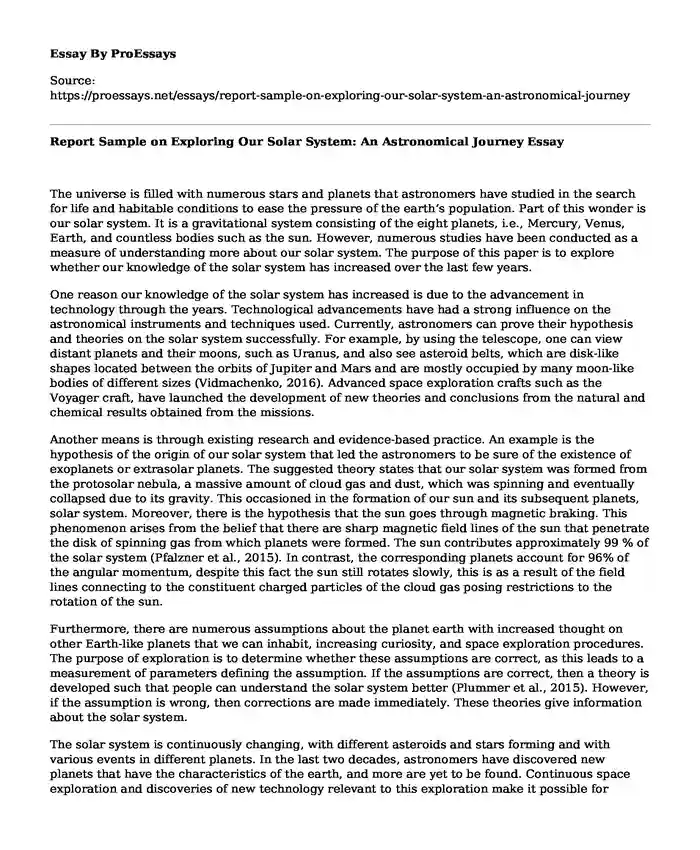The universe is filled with numerous stars and planets that astronomers have studied in the search for life and habitable conditions to ease the pressure of the earth’s population. Part of this wonder is our solar system. It is a gravitational system consisting of the eight planets, i.e., Mercury, Venus, Earth, and countless bodies such as the sun. However, numerous studies have been conducted as a measure of understanding more about our solar system. The purpose of this paper is to explore whether our knowledge of the solar system has increased over the last few years.
One reason our knowledge of the solar system has increased is due to the advancement in technology through the years. Technological advancements have had a strong influence on the astronomical instruments and techniques used. Currently, astronomers can prove their hypothesis and theories on the solar system successfully. For example, by using the telescope, one can view distant planets and their moons, such as Uranus, and also see asteroid belts, which are disk-like shapes located between the orbits of Jupiter and Mars and are mostly occupied by many moon-like bodies of different sizes (Vidmachenko, 2016). Advanced space exploration crafts such as the Voyager craft, have launched the development of new theories and conclusions from the natural and chemical results obtained from the missions.
Another means is through existing research and evidence-based practice. An example is the hypothesis of the origin of our solar system that led the astronomers to be sure of the existence of exoplanets or extrasolar planets. The suggested theory states that our solar system was formed from the protosolar nebula, a massive amount of cloud gas and dust, which was spinning and eventually collapsed due to its gravity. This occasioned in the formation of our sun and its subsequent planets, solar system. Moreover, there is the hypothesis that the sun goes through magnetic braking. This phenomenon arises from the belief that there are sharp magnetic field lines of the sun that penetrate the disk of spinning gas from which planets were formed. The sun contributes approximately 99 % of the solar system (Pfalzner et al., 2015). In contrast, the corresponding planets account for 96% of the angular momentum, despite this fact the sun still rotates slowly, this is as a result of the field lines connecting to the constituent charged particles of the cloud gas posing restrictions to the rotation of the sun.
Furthermore, there are numerous assumptions about the planet earth with increased thought on other Earth-like planets that we can inhabit, increasing curiosity, and space exploration procedures. The purpose of exploration is to determine whether these assumptions are correct, as this leads to a measurement of parameters defining the assumption. If the assumptions are correct, then a theory is developed such that people can understand the solar system better (Plummer et al., 2015). However, if the assumption is wrong, then corrections are made immediately. These theories give information about the solar system.
The solar system is continuously changing, with different asteroids and stars forming and with various events in different planets. In the last two decades, astronomers have discovered new planets that have the characteristics of the earth, and more are yet to be found. Continuous space exploration and discoveries of new technology relevant to this exploration make it possible for astronomers to inform us of the latest events in outer space. This factor comes in a bid to find extra-terrestrial life or perhaps a planet that humankind and call home, especially since the earth is slowly degenerating as the population grows. Space exploration has had numerous benefits, exposing individuals to new stars and alerting on events like the solar and lunar eclipse and meteor showers as well. There is more that needs to be done to understand concepts like dark matter and other existing galaxies near the earth’s solar system.
References
Vidmachenko, A. P. (2016). The activity of processes on the visible surfaces of Solar System bodies. Astronomical School’s Report, 12(1), 14-26.
Pfalzner, S., Davies, M. B., Gounelle, M., Johansen, A., Münker, C., Lacerda, P., & Veras, D. (2015). The formation of the solar system. Physica Scripta, 90(6), 068001.
Plummer, J. D., Palma, C., Flarend, A., Rubin, K., Ong, Y. S., Botzer, B., & Furman, T. (2015). Development of a learning progression for the formation of the solar system. International Journal of Science Education, 37(9), 1381-1401.
Cite this page
Report Sample on Exploring Our Solar System: An Astronomical Journey. (2023, Oct 21). Retrieved from https://proessays.net/essays/report-sample-on-exploring-our-solar-system-an-astronomical-journey
If you are the original author of this essay and no longer wish to have it published on the ProEssays website, please click below to request its removal:
- Literature on Virtual Reality
- Biography of Isaac Newton
- Research Proposal on Impact of Artificial Intelligence on Audit Firms
- How Surfactants Modify the Surface Tension and Why Essay
- Essay Example: Will AI Help or Threaten Humanity?
- Research Paper on Math for Kids
- The Mobile Revolution: Catering to Consumers' Needs &Preferences - Essay Sample







